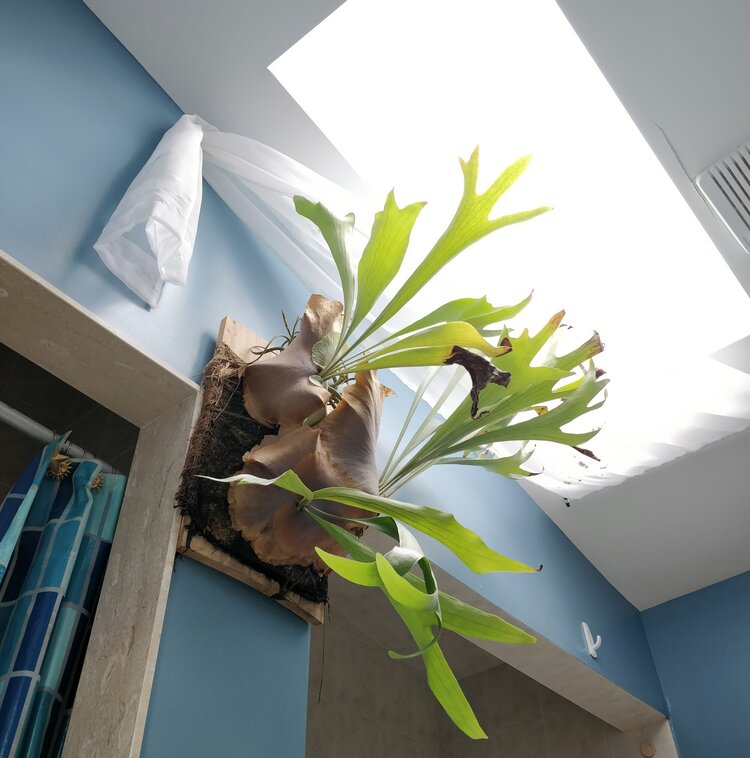For quite some time, I have been describing “bright indirect light” like this:
Put your plant where it will have the widest possible view of the sky and some direct sun is tolerable (usually 2-3 hours depending on the plant).
At first, some people thought I was saying if you do this (putting the plant where it has the widest possible view of the sky), your plant will grow perfectly fine…NO! That’s not what it means. The real implication is this:
You need to put your plant where it will have the widest possible view of the sky because that’s the spot with the best possible DLI – and your plant will only grow as nicely as your DLI can allow (and indoors, it’s WAY less than a commercial nursery).
At a very high level, DLI is just a number that tells you how much light your plant is getting – it’s the number of photons that your plant receives through a 24-hour period. In part 2, we’ll get into the details.
So why don’t people discuss DLI?
My guess is because people who sell plants wouldn’t be inclined to discourage people from buying a certain plant if their interior space just didn’t have the DLI necessary for “nice growth” of a particular plant. A number is clear cut but vague words like bright indirect light with a hint of superstition (greenthumb) keep things mysterious for the hopeful plant parent.

It’s so easy to put the blame on the person for “improper watering” but if people knew just how bad the DLI was in most areas of their home, perhaps they would not have bought that plant in the first place – so it’s understandable that people who sell plants would be weary of such quantitative methods.
Another reason is measuring DLI is time consuming, requires specialized equipment, and the number you get only applies for that particular spot at that particular time of the year (and on a clear day). With all the complexity involved, it’s no wonder DLI was left out of the common houseplant care tips and tricks.
Why I think you SHOULD (at least) understand DLI
Disappointing experiences in houseplant care (or anything in life really) arise when expectations are unmet. Houseplants are often portrayed as decor that requires maintenance, which is why the headlines about houseplants are always “super easy” and “hard to kill” – when you read these, your expectations are: if I do this properly, the plant will look perfect and live forever.
I have a more realistic approach: understand that the best your plant will grow is determined first by the DLI of the spot where your plant lives, and second, by your supporting actions (watering, fertilizing, repotting). The third part is on you: keep your expectations in line with how Nature works. By the way: do you see how the above three things are just different ways of saying the House Plant Journal philosophy of houseplant care? 1 – Understand your environmental conditions; 2 – try your best with care; 3 – let Nature take its course.
Ultimately, when you understand DLI, you will understand the significant setback your plants are taking when they live in your home, which is equivalent to a cave with small openings (which we call windows). Maybe you won’t be so hard on yourself when you realize how drastically low the DLI is in most areas of your home. On the flip side, think about that friend who always seems to have beautiful looking plants and says things like “plants are so easy – I just have to water!” – this person probably has LARGE, unobstructed windows on multiple sides of their home!
Basically, what I’m saying is differences in DLI between people’s growing spaces is the MAIN reason why some people seem to “do better” with houseplant than others. Yes, knowledge of watering, fertilizing, and repotting contribute (and also differences in what people expect from their plants) but DLI from natural light is pretty much set by your location and the dimensions of your windows.
That’s all for part 1 of our discussion: the prequel to DLI – it’s just all things to THINK about. In part 2, I’ll do a sample measurement of DLI so get your light meters ready – foot-candles or PAR is fine.
Affiliate links: As an Amazon Associate I earn from qualifying purchases. Thank you for supporting the work of House Plant Journal: The Sensible Approach to Houseplant Care.
My trusty light meter: https://amzn.to/317tUqu
PAR meter: https://amzn.to/2A3j88Q